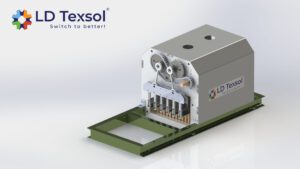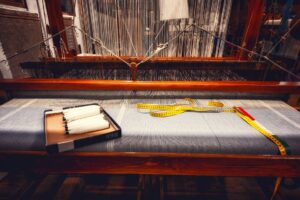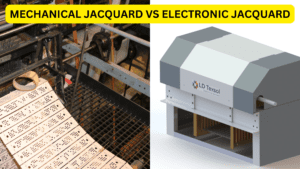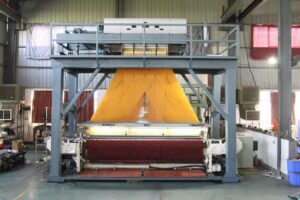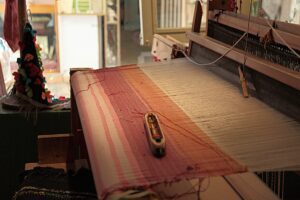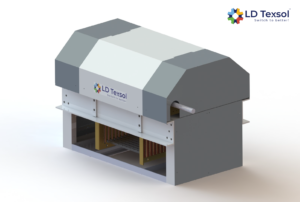Introduction
In the textile industry, the ability to create complex, intricate designs has always been in high demand. The Jacquard machine, first invented in 1804, revolutionized weaving by automating the control of warp threads to create beautiful, detailed patterns. Fast forward to today, and the electronic Jacquard machine takes this innovation even further, offering greater efficiency, precision, and design flexibility for textile manufacturers.
If you’re a textile manufacturer or someone interested in the latest weaving technologies, you’ll want to know why electronic Jacquard machines are becoming essential in the modern textile landscape. This blog covers everything you need to know, from what these machines are, their key components, and how they work, to their advantages over traditional mechanical Jacquard systems.
What is an Electronic Jacquard Machine?
An electronic Jacquard machine is a sophisticated weaving device that operates by lifting and lowering individual warp threads based on electronically controlled instructions. This precise control makes it possible to weave complex patterns directly into the fabric, with minimal human intervention. Unlike the original Jacquard machines, which relied on punch cards to create designs, the electronic versions use digital signals for greater flexibility and faster operation.
Today, electronic Jacquard machines are used in various sectors of the textile industry, from apparel and upholstery to carpets and technical fabrics. Textile manufacturers rely on these machines to produce high-quality, intricate designs that would otherwise be too time-consuming or labor-intensive using traditional methods.
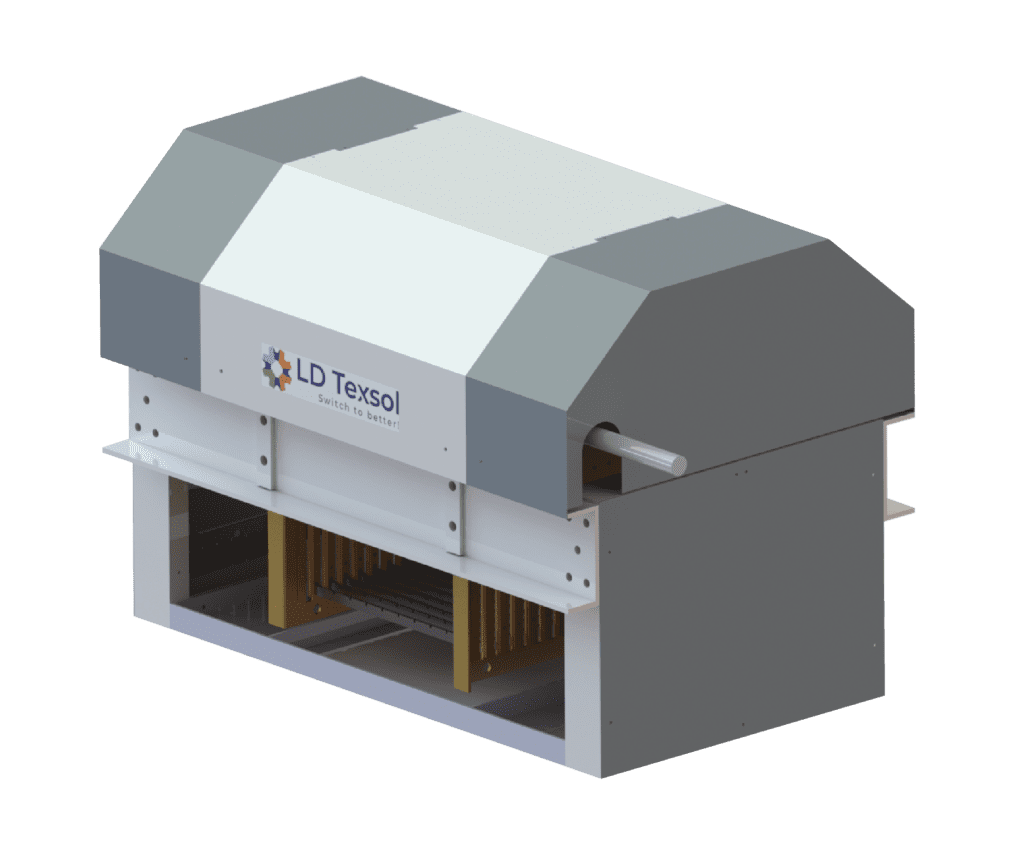
Key Components of an Electronic Jacquard Machine
Let’s take a closer look at the key components that make the electronic Jacquard machine such a powerful tool for textile manufacturing:
-
Electronic Controller: The Ciel card controls the motion of every hook in the module for each pick. It sends signals to the electromagnets in the M5 modules, which operate the hooks. The Ciel card receives signals from the motherboard or the CICO card, acting as the command center of the machine.
-
Hooks: Hooks are controlled by the signals from the Ciel card. The magnets turn on and off accordingly, which causes the up-and-down motion of the warp threads. This motion is what creates the fabric design as the machine weaves.
-
Harness: The harness consists of cords and heddles that guide the warp threads. It connects the hooks to the warp. At the bottom of the harness, a spring assembly provides the necessary tension, which helps the harness change its position smoothly, ensuring the correct movement of the warp threads.
-
Weaving Loom: The loom provides the basic structure where warp and weft threads interlace. In Jacquard weaving, the loom works in conjunction with the Jacquard mechanism to interlace the warp and weft threads as dictated by the pattern.
-
Pattern Data Input: The digital design file, often created using specialized textile design software, is input into the machine. This allows for real-time changes to designs, giving manufacturers unparalleled flexibility in production.
-
Rapier Jacquard Mechanism: Some electronic Jacquard machines utilize a rapier Jacquard mechanism, which uses a rapier to transfer the weft thread through the shed (the gap between raised and stationary warp threads). This method is faster and more efficient than the shuttle method used in traditional looms, making rapier Jacquard machines a popular choice among manufacturers.
How Does an Electronic Jacquard Machine Work?
To understand the working of an electronic Jacquard machine, it’s essential to grasp the interaction between digital control and mechanical components. Here’s a step-by-step explanation of how these machines operate:
-
Pattern Input: The process begins with a digital design created using textile design software. The designer transfers this pattern to the machine’s electronic controller, typically through a USB drive or direct software integration.
-
Digital Control: Once the pattern data is uploaded, the Ciel card in the electronic controller takes over. It processes the design and sends commands to the hooks, determining which warp threads should be lifted and which should remain stationary. The Ciel card ensures every hook’s motion aligns with the pattern for every pick.
-
Lifting the Warp Threads: The hooks respond to the electronic signals by lifting specific warp threads at precise moments. The threads that are lifted create the “shed,” or the gap through which the weft thread will be passed. This movement of warp threads is what forms the woven pattern.
-
Weft Insertion: In rapier Jacquard machines, a rapier carries the weft thread across the warp threads. As the rapier moves back and forth, it inserts the weft thread into the shed, gradually forming the woven design.
-
Repetition and Completion: This process continues, with the warp threads being lifted or lowered according to the design. The machine repeats the process until the entire fabric is completed, with the pattern seamlessly integrated into the weave.
Advantages of Using an Electronic Jacquard Machine
There are several reasons why textile manufacturers are increasingly choosing electronic Jacquard machines over traditional mechanical Jacquard systems. Here are some of the key advantages:
-
Greater Precision: The digital control in electronic Jacquard machines allows for incredibly precise manipulation of warp threads. This means manufacturers can create complex, intricate designs with far more accuracy than ever before.
-
Increased Productivity: Since the electronic machine operates much faster than its mechanical counterpart, manufacturers can produce more fabric in less time. This boost in productivity leads to higher profitability.
-
Design Flexibility: One of the standout features of electronic Jacquard machines is their ability to handle frequent design changes. With mechanical Jacquard looms, altering a pattern required changing punch cards, which was both time-consuming and labor-intensive. Now, manufacturers can switch patterns at the push of a button.
-
Reduced Labor Costs: Electronic control reduces the need for manual labor. Once the design is input into the system, the machine automates most of the weaving process, significantly cutting down on labor costs.
-
Higher Quality Fabrics: Electronic Jacquard machines can produce more consistent and high-quality fabrics, thanks to their precision. Whether it’s intricate upholstery, detailed apparel, carpets, or sarees, manufacturers get top-tier results.
Applications of Electronic Jacquard Machines
Electronic Jacquard machines have a wide range of applications in different sectors of the textile industry:
- Apparel: From intricate patterns in high-end fashion to everyday fabrics, Jacquard weaving helps create unique, textured designs.
- Home Textiles: Curtains, upholstery, and bedding often feature woven patterns created using Jacquard looms.
- Automotive Textiles: Many vehicles use fabric with woven designs in the interior, which are often made using rapier Jacquard machines.
- Technical Fabrics: These machines are also used to produce technical fabrics that require precise, complex weaving for specialized uses.
Why Choose an Electronic Jacquard Machine Over a Mechanical Jacquard?
When considering an upgrade from a mechanical Jacquard loom to an electronic Jacquard machine, several factors come into play:
-
Speed: Electronic Jacquard machines are faster, meaning more fabric can be produced in less time. This is particularly beneficial for large-scale manufacturers.
-
Efficiency: The ability to change patterns digitally reduces downtime between production runs. Manufacturers can quickly shift from one design to another without needing to manually adjust the machine.
-
Lower Maintenance: Mechanical Jacquard systems involve more wear and tear due to the complexity of their moving parts. Electronic systems, on the other hand, tend to require less maintenance and have longer lifespans.
-
Better Design Capabilities: With electronic control, there’s virtually no limit to the complexity of patterns you can create. Mechanical systems are limited by the constraints of punch cards, whereas electronic Jacquard machines can handle highly detailed and intricate designs with ease.
Conclusion
In conclusion, the electronic Jacquard machine represents the future of textile manufacturing. With its precision, speed, and design flexibility, it has quickly become the go-to choice for manufacturers looking to produce high-quality, intricate fabrics. Whether you’re in the fashion industry, home textiles, or technical fabrics, investing in an electronic Jacquard machine can help streamline your operations, reduce costs, and enhance the quality of your products.
If you’re a business decision-maker looking to adopt the latest in textile technology, it’s time to consider partnering with an electronic Jacquard machine manufacturer. By doing so, you’ll stay competitive in today’s fast-paced market while delivering top-notch designs to your customers.
